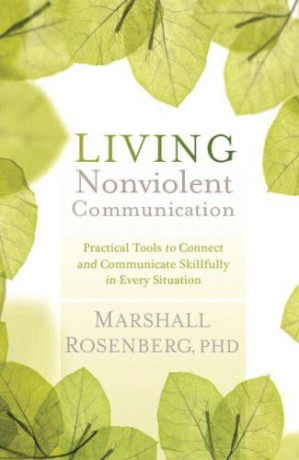Separate observations from evaluations.
The first component involves observing what's actually happening without mixing in evaluation or judgment. Clear observations free communication from the defensiveness that evaluations typically trigger.

Book summary
by Marshall B. Rosenberg
A language of life
Practical tools to connect and communicate
Topics
Practice one NVC component per week in daily conversations, starting with observations. Use Readever to highlight Rosenberg's framework and track your progress in transforming judgmental language. Use the AI to identify when you're mixing evaluations with observations and to help distinguish feelings from thoughts in your communication.
Things to know before reading
Marshall Rosenberg's Nonviolent Communication (NVC) provides a powerful framework for communicating with empathy and authenticity. The method helps people express themselves honestly while receiving others with empathy, transforming potential conflicts into opportunities for connection and understanding.
Rosenberg's Nonviolent Communication framework transforms communication from judgment and blame to empathy and connection.
The first component involves observing what's actually happening without mixing in evaluation or judgment. Clear observations free communication from the defensiveness that evaluations typically trigger.
The second component involves identifying and expressing feelings that arise from our observations. This requires distinguishing between actual feelings and thoughts or interpretations about what others are doing.
The third component involves recognizing that feelings arise from met or unmet universal human needs. By identifying the underlying needs, we can address the root causes of conflicts rather than just the symptoms.
Ready to continue? Launch the Readever reader and keep turning pages without paying a cent.
This summary reveals the four components of Nonviolent Communication: observations, feelings, needs, and requests. You'll learn to express yourself authentically without blame or judgment, listen empathetically to others, and create conversations that foster mutual understanding and respect.
Key idea 1
The first component involves observing what's actually happening without mixing in evaluation or judgment. Clear observations free communication from the defensiveness that evaluations typically trigger.
Remember
Key idea 2
The second component involves identifying and expressing feelings that arise from our observations. This requires distinguishing between actual feelings and thoughts or interpretations about what others are doing.
Remember
Key idea 3
The third component involves recognizing that feelings arise from met or unmet universal human needs. By identifying the underlying needs, we can address the root causes of conflicts rather than just the symptoms.
Remember
Nonviolent Communication presents a communication process developed by Marshall Rosenberg that helps people exchange the information necessary to resolve conflicts peacefully. The approach is based on the principles of nonviolence and has been used worldwide in diverse contexts including schools, businesses, prisons, and war-torn regions.
Rosenberg developed NVC as a way to create connections based on honesty and empathy. The process involves expressing ourselves honestly through the four components and receiving others empathetically through the same four components, creating a foundation for compassionate giving and receiving.
Open Readever's reader to highlight passages, ask the AI companion questions, and keep exploring without paying a cent.
Rosenberg's writing is both practical and profound, combining psychological insights with spiritual wisdom. The book has been praised for its transformative potential in improving communication and resolving conflicts. Many readers report that learning NVC has fundamentally changed their relationships and their approach to communication.
Critics appreciate the book's emphasis on empathy and connection, though some find the framework initially challenging to implement. The principles have been widely adopted in mediation, counseling, education, and organizational development contexts worldwide.
Anyone seeking to improve personal relationships
Counselors, mediators, and therapists
Educators and parents
Business professionals and team leaders
Marshall B. Rosenberg (1934-2015) was an American psychologist, mediator, author, and teacher. He founded the Center for Nonviolent Communication, an international nonprofit organization that teaches NVC in more than 65 countries.
Rosenberg developed Nonviolent Communication in the 1960s, drawing on his work in civil rights activism and his studies in clinical psychology. He spent his life teaching NVC worldwide, working in war-torn areas, schools, prisons, and organizations to help people resolve conflicts peacefully.
Build your personalized reading stack
Download full-length ePubs in one click with personal cloud storage.
Blend AI-guided insights with tactile note-taking to accelerate reflection.
Follow curated reading journeys tailored to your goals and time budget.
Sync highlights across devices so lessons stick beyond the page.
Sign in to Readever to keep reading with AI guidance, instant summaries, and synced notes.
Nonviolent Communication provides a powerful framework for transforming communication patterns from judgment and blame to empathy and connection. Rosenberg's approach reminds us that when we communicate with authenticity and empathy, we create the conditions for understanding, cooperation, and peaceful conflict resolution.
This extended outline captures Marshall Rosenberg's transformative framework for Nonviolent Communication. Use it to revisit the four components—observations, feelings, needs, and requests—that enable authentic expression and empathetic listening in all types of relationships.
The book's enduring value lies in its demonstration that communication based on empathy and authenticity can transform conflicts into opportunities for connection, creating more compassionate and effective interactions in personal, professional, and global contexts.
Start reading Nonviolent Communication for free and unlock personalized book journeys with Readever.